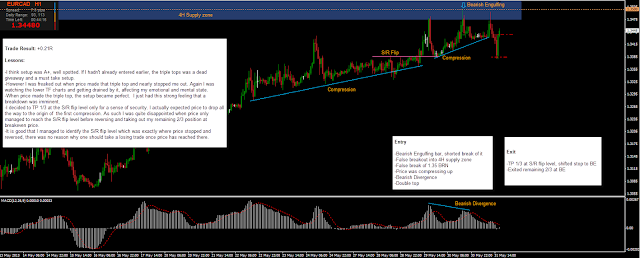 |
| Crude Oil Daily |
I found a good example to illustrate why supply/demand theory trumps traditional TA. In the chart above, price broke down of a huge triangle pattern and has retraced back.
Question: Why did the retracement not stop at the pink level I marked? Based on traditional TA it is a highly confluenced level, how did price just shoot through it without the slightest hesitation?
Answer: There were no sell orders there to stop the up move. The sell orders were located further up in the supply zone (purple rectangle) where price previously started dropping hard. As observed, this supply zone did halt the up move.
Question: Why does price need to retrace back to the prior supply zone? What benefit is there for the professional money?
Answer: Lets imagine you're a market maker. You profit from commissions and by trading against your clients. Suppose crude was trading at 93.5 but suddenly some major event caused prices to drop rapidly. Think of what is happening on the order book. Prices shot down rapidly because there was a sudden influx of huge sell orders and inadequate buy orders. So what we have on the order book is a lot of unfilled sell orders at 93.5. This is known as a
liquidity gap. Being an intelligent market maker, you know two things:
- You know that if you drop price hard and fast enough, a lot of amateurish retailers are going to jump in and short the market. Also, a lot of prior bulls will capitulate and cut losses on their longs.
- Because you can see your clients' orders, you also know that there are huge unfilled sell orders at 93.5.
So what do you do? You spike the market down to entice amateur bears and shake out longs. Their selling will provide the liquidity for you to go long. Next you pump price up, this time round the amateur bears will get stopped out and add fuel to the up move. As prices go higher more and more late bulls will jump in, providing you the liquidity to take profits on your prior longs. These late bulls and shaken out shorts will also provide the liquidity for the prior unfilled sell orders to be filled, and that means more commissions for you because you're a market maker. See how it works? Prices move from zones to zones. Of course this is my own interpretation and I might only be partially right.
This is just one example, I see it over and over again in every chart in every time frame. I'm not saying that traditional TA doesn't work, in fact it does present a tradable edge. Fibs and trend lines etc do work, but from experience I feel that there has to be minimally some confluence and supporting price action for them to work. Also, to my pleasant surprise I noticed that many times when I find setups at S/R flip levels or confluenced levels, those that do work are often also at supply/demand zones.
I really really need to study the RTM forums more and put everything together. It is frustrating because I see a lot of things in hindsight but somehow fail to trade them effectively at the right side of the chart. Actually, it is more like I do pick pretty decent setups but end up sabotaging my trades by over managing them. Looking forward to a month of intensive study!





















